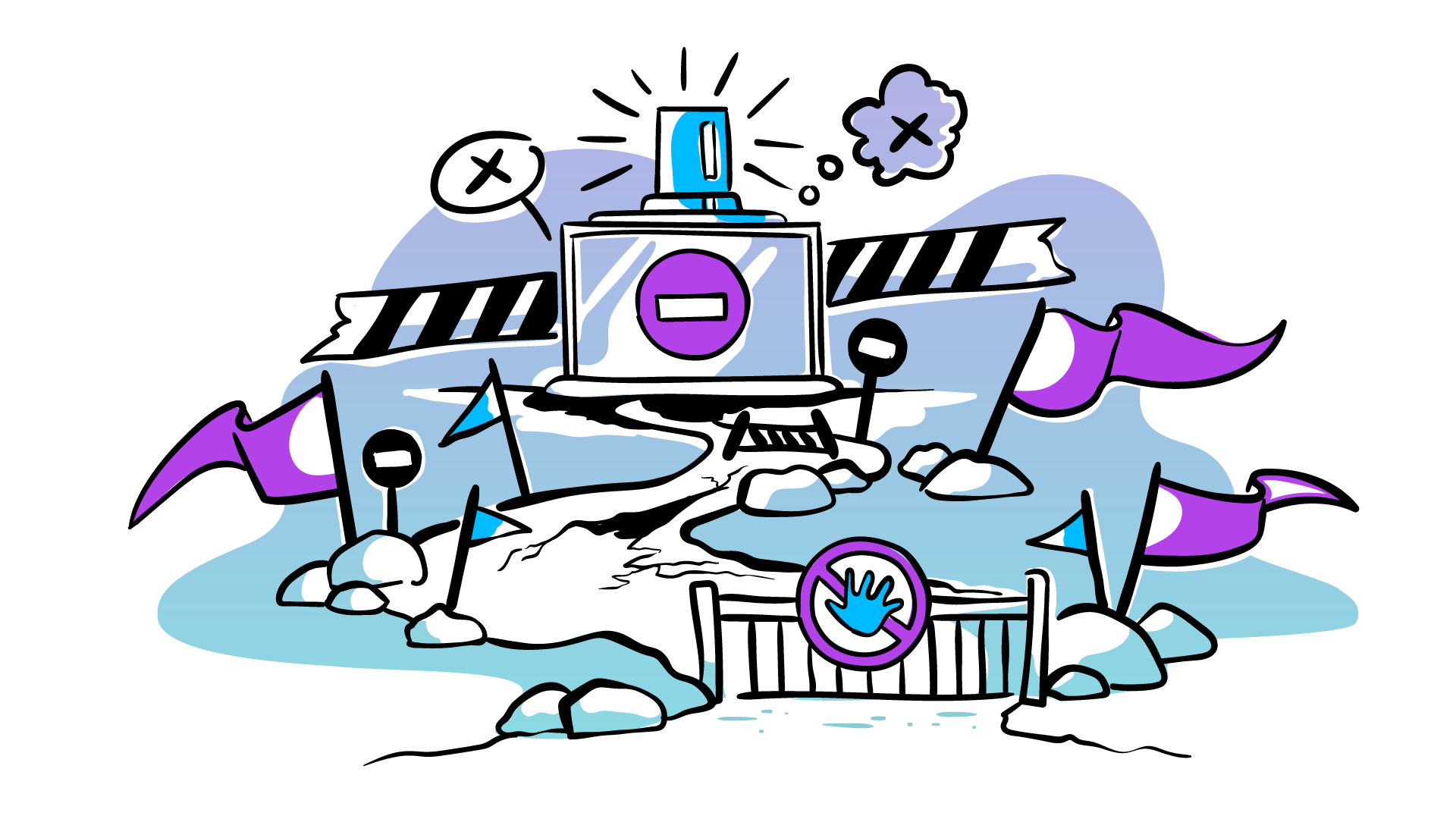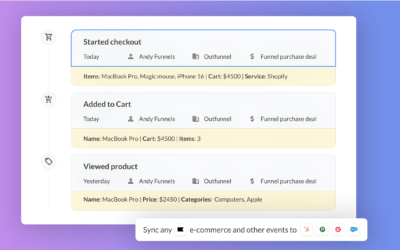The B2B marketing landscape is constantly evolving, but one thing stays the same—the everlasting question of what to do to generate leads and how lead generation works.
Regardless of the industry, product or service, this question especially bugs marketing teams – me too, as a content marketer – forever tired of the other dreaded question periodically coming from sales—”Why have these leads not converted?”
Chances are, you either did not do your follow-up homework, you delivered irrelevant marketing messages, or you let your competitors and their well-structured marketing efforts win the leads instead.
Or simply, (sigh), they were not high quality leads in the first place. You got an outdated list from three years ago and sent some random emails. Or you ran a Google ad campaign to an audience of 7M of people, and this is how you got those leads.
No problem – I’ve been there too.
Then, what’s the right way to follow? How can you generate leads – leads that convert and help you increase your revenue?
To show you what you should do, here are seven things you should NOT do when you want to generate high-quality leads (including the ones sadly I’ve done before as well):
1. Skipping a free trial offer
2. Writing poor and sales-heavy cold emails
3. Avoiding email marketing
4. Using lots of buzzwords and marketing jargon everywhere
5. Creating only one landing page
6. Forgetting about content marketing
7. Ignoring the power of social media
Let’s start with the most common mistake that would cause you to miss out on high-intent leads.
1. Skipping a free trial offer.
Let’s start with the definition of free.
A free trial gives your potential customers (AKA leads) partial or complete access to your product for a specific period of time.
The goal here is to encourage prospects to use your product, get the most out of it during the trial period, and hopefully make a purchase decision at the end.
Here at Outfunnel, we offer a 14-day free trial that enjoys a 15% – 20% conversion success rate.
According to Product Marketing Alliance, offering free trials:
- develops customer advocacy programs
- helps differentiate your product from the competition
- fosters product engagement
- enables receiving feedback from users
- offers an opportunity to incentivize customers
Last but not least, it helps reach high-intent prospects already in-market looking for a solution to their business problem and willing to try out your product. Thus, they’re more likely to be ready to make a purchase decision, meaning the most-coveted word for sales and marketing teams is on the horizon: conversion.
They are the leads you want, they are the real deal. Meet the PQLs (product-qualified leads). Want to generate leads – leads that are high-quality and likely to convert? Then, add a free trial as a limited-time offer to your marketing strategy.
If you cross offering free trials off your list, you could miss out on these all important PQLs.
Not a SaaS company?
You can still offer free consultation services.
Make a short company audit for your hopefully soon-to-be client or present the 3 quick fixes you’ve identified in their company, and get ready to welcome a higher number of leads than you imagined.
My experience shows that this tactic works pretty well for advertising and PR agencies (managed to find four clients within eight months that way) as well as consultation firms.
By doing so, you can both demonstrate your expertise and offer value (for free) to your future clients.
Friendly note: Free signups are one of the most important explicit attributes in lead scoring. You wouldn’t want to miss out on them.
2. Writing poor and sales-heavy cold emails
What would top a LinkedIn connection request from a stranger working at a company you’ve never heard of before with an instant call to action asking you to buy a product?
Maybe a cold email without a real, human-sounding sender name, attention-grabbing subject line, or an engaging hook at the beginning?
Or a message without any clarity about the next steps for the prospect?
In case you didn’t get the memo, these are all competing in the “Top Annoying Marketing Move” category.
Cold emails are an important part of sales strategy for most B2B businesses. An old lead generation tactic. Whether we like reaching out to strangers jostling to sell our product or not, we all get involved with writing cold emails at some point.
So, whether you see it as an outdated marketing tactic or a blessing in disguise, cold emailing is still very much in the lives of all marketing and sales teams.
Being part of an in-house marketing team at a B2B company, I receive at least five cold emails each single day. The industry varies – mostly marketing software as expected – but one thing stays the same—the emails are boring, far from being engaging or intriguing.
So, it’s no surprise that I rarely open those emails and bother responding them.
Here are five things that each one of those “rare emails” includes (thus helps generate leads):
- Clarity, from the sender’s name, to what the company does and how the product can solve the prospect’s problem
- A strong subject line invoking curiosity with a sneak peak into the pitch
- An appealing hook at the beginning of the email that not only pairs up with a compliment but also shows that you are aware of what the prospect’s business is up to nowadays
- A strong pitch that addresses how your product will solve the prospect’s problem
- Clear next steps on how to proceed, be that a call or an online or in-person meeting
3. Avoiding email marketing
According to Campaign Monitor’s stats, email marketing has delivered the highest ROI of all channels for the past ten years and has the highest conversion rate (66%).
Plus, email is 40 times more effective in new customer acquisition when compared with social media.
So, if you want to generate high-quality sales leads, don’t avoid email marketing.
Spend time creating insightful email flows based on where each segment is in the funnel. Send valuable content such as guides, tutorials, or anything that might help your prospects. Make sure you avoid spam trigger words in your emails.
We’ve all seen marketing emails with no care taken over the design elements. Poor emails stuffed with text or even worse, pointless images. So, the reader will have to scroll all the way down the email to see what the goal is. If there even was one in the first place.
While email marketing is often just a part of a long-term nurture strategy, it matters in terms of educating your leads and converting them over time with the help of consistent communication.
To learn more about how email marketing can help your business, sign up for our B2B Email Marketing crash course. You’ll learn how to build an email marketing strategy scratch along with useful tips on email content and design.
Once you know more about email strategy and design, the next step is to craft the emails.
Want to easily create beautiful email newsletters and increase engagement? Take a look at the options the email marketing platform Sender offers. There are various templates for different businesses and needs.
If you want to see some examples, here you go!
4. Using lots of buzzwords and marketing jargon everywhere
Can we please not transform your business with X anymore?
And simply stop offering world-class and innovative solutions?
Not to mention the soul-wrenching cutting-edge technologies and robust processes…
There was a reason author and cartoonist Hugh MacLeod once said:
“If you talked to people the way advertising talked to people, they’d punch you in the face.”
And that statement – especially the “getting punched” part – would sadly apply to most of today’s B2B marketers.
As a former Copywriter, I might have agreed this argument once when I first started B2B marketing. That misleading argument was “We have to define our product and services, so let’s stick to the terminology in terms of accuracy.”
But, what about clarity?
When it comes to marketing messages, what the audience wants – if they want anything from marketing at all – is meaningful content, clarity, and relevance.
Nobody wants a mess of marketing clichés and buzzwords they barely understand.
Nobody wants dull, boring, repetitive, non-flowing text.
That being said, nobody wants to deal with a cryptic puzzle, purely written for the sake of creativity and playfulness, either.
The audience, especially the ones who know exactly what they need with the intent to make a purchase, simply does not have any time to decipher our messages.
Sophistication does not have to be complicated, and “simple” does not mean “dull”.
Just because it is B2B, it does not have to be repetitive and boring.
That would make a good tattoo for B2B marketing professionals who want to generate high-quality leads.
5. Creating only one landing page
The message you need to deliver to your audience depends on where they are in the funnel.
And here comes your checklist to find your target audience in the funnel and locate them in your customer journey:
- What problem do they have?
- How can your product(s) and/or service(s) solve their problem?
- Are they familiar with your product?
- Have they visited your website before?
- Do they follow your social media accounts?
- Have they attended any of your webinars?
And the key one:
- Why would they even care about your product or service?
If you want to miss out on converting sales leads, one of the fastest ways to sabotage your marketing efforts is to overuse the same message to everyone regardless of who they are, what they need, and where they are in the funnel.
The reverse scenario would be:
- segmenting your target audience based on the questions above
- defining your personas
- creating dedicated landing pages each addressing a solution to that particular segment’s problem
In Outfunnel, we have over 1000 landing pages (yes, you read it right), speaking to different audiences highlighting different needs and solutions – more to come.
Mistaking brand consistency for sharing the same message with everyone in the funnel vs. message customization based on customer insights.
The ball is in your court.
6. Forgetting about content marketing
Did Bill Gates foresee the future when he wrote an essay titled “Content is King” back in 1996?
According to Hubspot’s 2022 State of Content Planning Report:
- 66% of marketers expect to invest more in their 2022 content marketing efforts than last year
- More than 60% of marketers review their content marketing strategy success based on sales results
Does that tell you something about content marketing?
From SEO tactics and blog articles to social media channels and industry reports, content marketing aims to deliver value to your audience, be that an existing client or a fresh lead.
It creates brand awareness, inspires your audience, motivates them to take action, and, last but not least, when planned and implemented strategically, has the potential to skyrocket the sales numbers on your spreadsheet in the long-run.
Creating valuable content is the key to success for B2B marketers. This is Marketing 101. Yet it is not simple to master.
Want to generate leads for your B2B business? SEO-optimized, informational blog articles with a strong link-building strategy in particular can help you drive more leads.
Here at Outfunnel, we see SEO-optimized content as one of the most important pillars of our overall marketing strategy. Long live demand generation and inbound marketing.
As the Head of Content Marketing at Outfunnel, my goal is to connect “what the audience needs” with “what we can offer them” in the best Google-friendly way as possible. Yet, the priority is always sharing valuable content.
And our goal as a team is to make Outfunnel more visible thus reachable and available on the web. The stats show that we are on the right track.
For a high-converting – and lead-friendly – content marketing strategy, you need to incorporate the latest trends into your plans in addition to listening to what your audience wants. You also need to measure the effectiveness of the tactics you used in order to surface the attribution data and optimise when necessary.
- Google loves valuable in-depth content more than ever. Aim to boost your SERP rankings and look for less broad keywords that can be hidden gems for your content.
- Short-form videos have been reigning since 2019. Use them in your social media channels to drive more engagement.
- Just because yours is a B2B company it does not mean that LinkedIn is the only social media platform your product can ever exist on.
Speaking of which…
7. Ignoring the power of social media
“Social media does not work for B2B marketing. Only LinkedIn does. Maybe Twitter. We are dealing with companies, not end users.”
How many times have you heard the nay-sayers droning on along these lines? My experience shows that the social media landscape has evolved quite fast, so has the nature of B2B marketing.
Otherwise a tax management PaaS company would not be able to grow its LinkedIn community by 20% within three months, would it? (Based on a true story.)
Image Source: Pexels
To refresh our memories about the evolution of social media, let’s rewind the last 18 years.
FB was born in 2004, and it became a worldwide hit.
In 2010, IG was born. Over time, FB lost its spark.
Launched in 2016, TikTok became addictive soon enough.
Having lost its throne, IG became the “good old” FB.
(As a side note, in 2021, FB was the second largest digital ad publisher after Google in the US, generating 23% of total digital advertising revenue.)
Now in 2022, TikTok has evolved into a digital hub for experts from a variety of fields showcasing their knowledge in a fun way.
Not to mention, Twitter has become the meeting point for tech companies.
Remember the moans of the nay-sayers?
If everything changes, including the social media platforms, their features, and audiences, why shouldn’t B2B marketing strategies?
Why not search for different opportunities for your business in the social media world as well?
That being said, we don’t mean that you need to have accounts on every single platform, get carried away with every latest trend, publish dancing cat videos for the sake of getting attention, or spend your ad budget on irrelevant campaigns.
It depends on your product, service, audience, and where you’re heading as a company.
Yet, you can still explore different possibilities and look for hidden corners of the web to find your customers in.
While finding high-quality leads for the US is possible through LinkedIn, it’s Xing for the German market.
If we’re talking about China, WeChat is a huge player.
Maybe today, FB is very irrelevant to your business, but things may change with their upcoming updates.
At the end of the day, it’s all about engaging with the audience, understanding their needs, clearly offering relevant solutions, and growing your community.
For example, TikTok would be quite irrelevant to Outfunnel two years ago. But today, I can imagine our team sharing their expertise and knowledge there in the B2B field. So, yes, that was kind of a spoiler. Get ready to follow us on Instagram and TikTok soon – stay tuned!
If you are still not convinced about the importance of social media for B2B marketing, have a look at these examples:
- Mailchimp uses Instagram (173k followers as of today) and LinkedIn (164k followers) effectively, not only highlighting product features but also sharing profiles and tips from their partner community.
- Shopify gets the most out of YouTube by sharing compelling video content on a consistent basis.
The other successful social media tactic the company uses is sharing success stories. That helps grow the community, increase engagement, and build trust which increases the likelihood of a higher number of clients.
So what can we conclude?
While there is no one-size-fits-all solution for all B2B companies, we can use data and common sense to generate and convert high-quality leads, and learn more from real-life case studies – inspiring lead generation examples. Time is money, and no one wants to deal with irrelevant leads taking lots of hours and energy from their team. I certainly would not – would you?
Try Outfunnel’s new tool—Predictive Lead Scoring
Meet our new feature – predictive lead scoring – that will help you analyze leads and lead sources, and focus on the high-converting ones, so you can close more deals, and increase revenue.
Predictive lead scoring will help you leverage your lead generation efforts, so you know whom and when to focus.
Now you can get started with predictive lead scoring in three easy steps:
1. Connect your sales and marketing sources
2. Build a custom predictive lead scoring model
3. Get new leads in a way that fits your processes
If you’re using Salesforce, HubSpot, Copper, or Pipedrive as your CRM and are interested in hearing more, get started today and enjoy early access!



